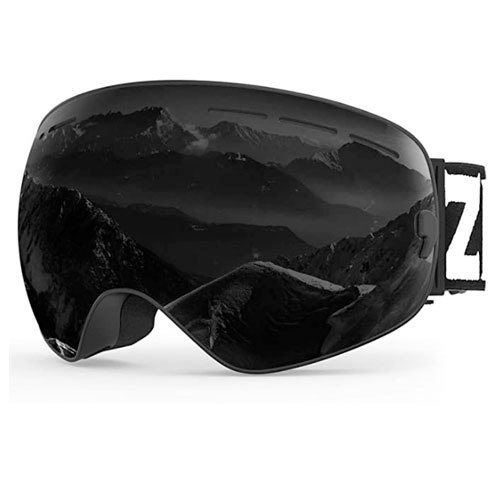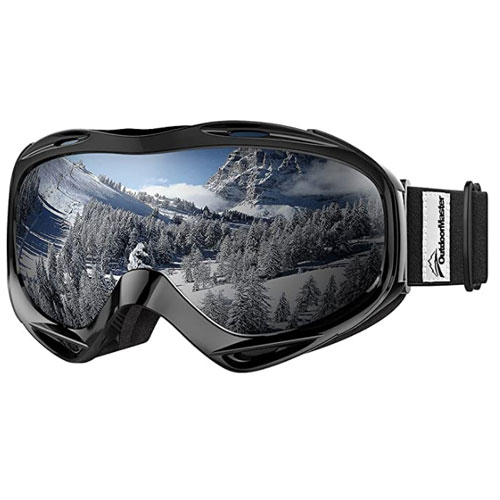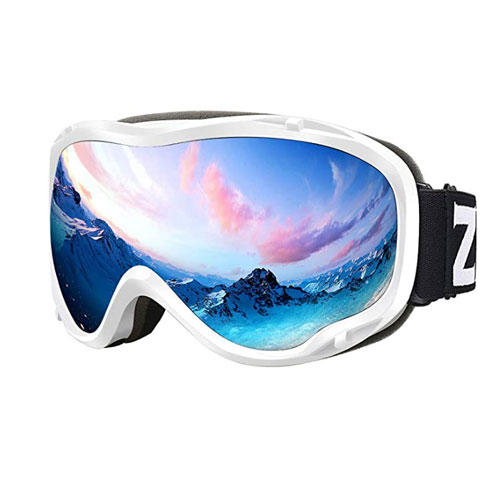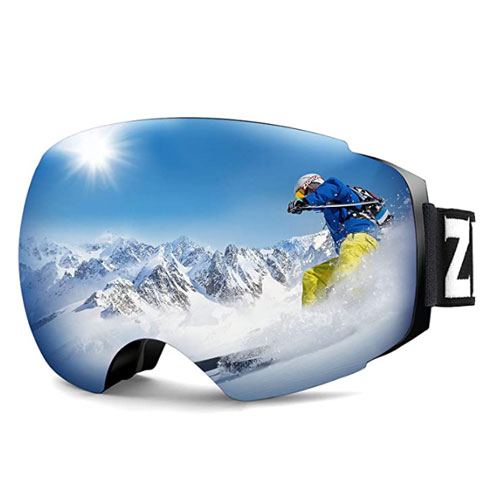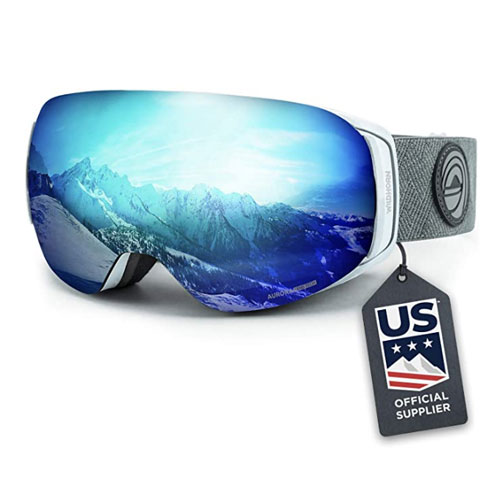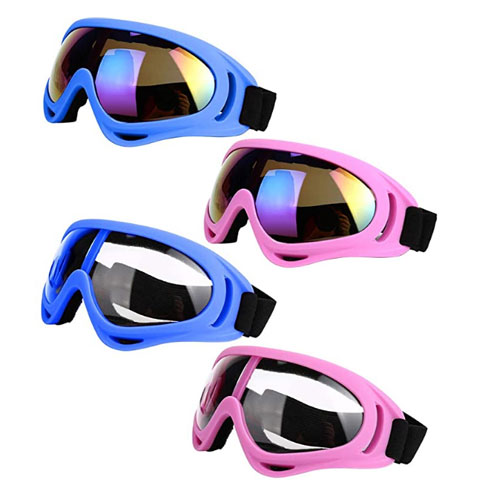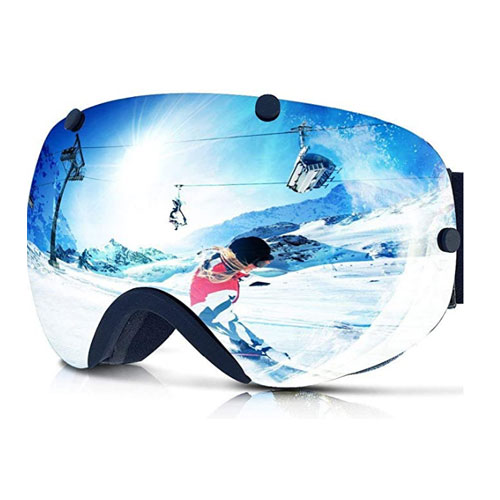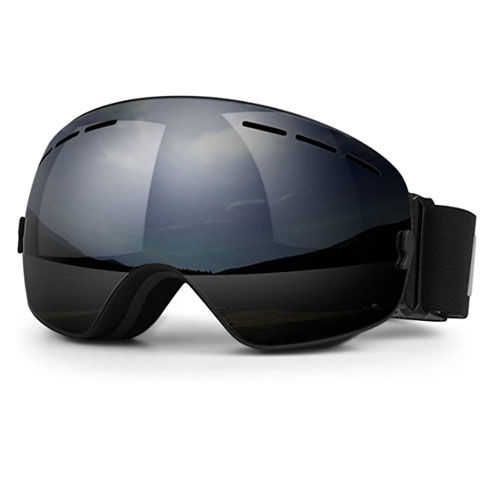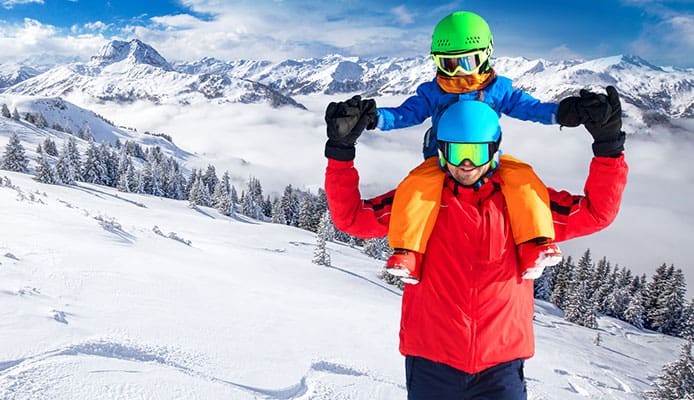
-
1.
-
2.
-
3.
-
4.
-
5.
-
6.
-
7.
-
8.
For skiers, flat-light is one of the most dangerous conditions on the mountain. It causes loss of depth perception and contrast, so you might struggle to identify changing terrain conditions like bumps and dips. On top of this, it makes determining your speed very difficult. One of the best ways to combat flat-light conditions is to use flat light ski goggles.
Thanks to their specific lens design, flat light ski goggles balance the visible light and increase the contrast, subsequently making the ride safer. However, choosing a good pair of VLT goggles is more than just selecting the right visible light transmission.
To help push skiers in the right direction, we have made a detailed goggle buying guide where we will discuss every feature. In addition, we’ve also selected the best flat light ski goggles currently available, guaranteed to make you feel confident on the mountain and increase your safety.
OUR TOP PICK
Zionor X
- Stand Out Features - Why We Love It
- Curved frame gives you an unobstructed 180-degree view
- Triple-layer foam on the frame provides all-day wearing comfort
- Enhanced Durability Technology improves lens durability
- Magnetic frame allows you to quickly and easily swap lenses
- Offers good peripheral vision
- Perfect for low light conditions
Best For: Wide View
Lens Color: Black
VLT Percentage: 13%
Lens Material: Polycarbonate with Enhanced Durability Tech (EDT)
Frame Material: TPU
UV Protection: Yes, UV400
Fits: Adults
EDITORS CHOICE
Outdoor Master OTG
- Stand Out Features - Why We Love It
- Wide frame easily fits over most standard prescription glasses
- Dual-layer lens technology improves performance and strength
- Vented frame prevents fogging on the inner lens surface
- Comes with a carrying bag for protection during transportation
- Perfect for low light conditions
Best For: Wearing Over Glasses
Lens Color: Gray, Mirrored
VLT Percentage: 11%
Lens Material: Polycarbonate
Frame Material: TPU
UV Protection: Yes, UV400
Fits: Youth, Adults
Dimensions: 7 x 3.6 inches
BEST VALUE
Zionor Lagopus
- Stand Out Features - Why We Love It
- Mirrored silver lens works well in flat light conditions
- Anti-fog coating on the inner surface prevents fogging
- Strong high-density strap with a buckle for easy adjustment
- Available in sizes for adults, youth, and children
- High quality lens technology
Best For: Helmet Compatibility
Lens Color: Silver
VLT Percentage: 8.6%
Lens Material: Polycarbonate
Frame Material: TPU
UV Protection: Yes, UV400
Fits: Youth, Adults
Dimensions: 6.89 x 3.54 inches
- Stand Out Features - Why We Love It
- Magnet attachment system (8 points) makes changing the lens quick
- Vents on top and bottom of the frame eliminate moisture and fog
- High-quality polycarbonate lens with Enhanced Durability Technology
- REVO coating on the front side reflects sunlight and reduces glare
- Offers good peripheral vision
- Perfect for low light conditions
Best For: Quickly Swapping Lenses
Lens Color: REVO SIlver
VLT Percentage: 8.59%
Lens Material: Polycarbonate with Enhanced Durability Tech (EDT)
Frame Material: TPU
UV Protection: Yes, UV400
Fits: Adults
Dimensions: 6.69 x 3.54 inches
- Stand Out Features - Why We Love It
- Panoramic spherical design gives the skier a wide view and prevents distortion
- Shatterproof polycarbonate lens with anti-glare and anti-UV protection
- Triple-layer padding on the frame ensures all-day comfort on the face
- Six N45 magnets allow you to swap interchangeable lenses in under 60 seconds
Best For: UV Protection
Lens Color: Ice Blue
VLT Percentage: 11%
Lens Material: Polycarbonate
Frame Material: TPU
UV Protection: Yes
Fits: Youth, Adults
Dimensions: 7.3 x 4 inches
LJDJ 4-Pack
- Stand Out Features - Why We Love It
- Goggle four-pack is ideal for families with children
- ABS plastic frame resists bumps and hits really well
- Highly-adjustable strap fits both adult and kid head size
- Bendable lens and frame won’t shatter under pressure
- Offers good field of vision
Best For: Families
Lens Color: Multi-Color
VLT Percentage: 10%
Lens Material: Polycarbonate
Frame Material: ABS Plastic
UV Protection: Yes, UV400
Fits: Youth, Adults
Dimensions: 7 x 3.1 inches
Zionor XA Dual Lens
- Stand Out Features - Why We Love It
- REVO reflective lens coating reduces the glare
- Several top and bottom vents allow free air circulation
- Frame and strap are compatible with any helmet
- UV400 protection shields your eyes from UVA and UVB
Best For: Glare Elimination
Lens Color: Silver with REVO Reflective Coating (Mirrored)
VLT Percentage: 8.4%
Lens Material: Polycarbonate with Enhanced Durability Tech (EDT)
Frame Material: TPU
UV Protection: Yes, UV400
Fits: Adults
Dimensions: 7 x 4 inches
Hongdak OTG
- Stand Out Features - Why We Love It
- Red lens color with 25.4% VLT for partly cloudy days
- Double polycarbonate layer improves lens strength
- Anti-scratch treatment on the surface improves durability
- Bendable TPU frame won’t get damaged or broken on impact
- High quality lens technology
- Offers good peripheral vision
Best For: Ventilation (Fog Removal)
Lens Color: Red with REVO Reflective Coating
VLT Percentage: 25.4%
Lens Material: Polycarbonate
Frame Material: TPU
UV Protection: Yes
Fits: Adults, Youth
Dimensions: 6.9 x 3.7 inches
How To Choose The Best Flat Light Ski Goggles – Buying Guide

Anti-Fog Features
When you’re already experiencing poor visibility, you don’t want to make it worse by having foggy low light goggles. Because of this, the best goggle for low light needs to have anti-fog features like vents on the top and bottom of the frame, double lenses, and anti-fog coating on the inner surface.
Straps and Adjustability
Straps are used to keep the goggles firmly in place on your head, so comfort and functionality are extremely important. Most straps are made from elastic materials and have an anti-slip grip. Stretchy straps can be easily placed around any ski helmet or adjusted for different head sizes.
Lens Color and VLT
The color of the goggle lens for low light helps increase the contrast or balance the percentage of VLT (visible light transmission). In flat light, you want a darker lens with a relatively lower VLT. On the other hand, night skiing goggles need to have clear lenses and a high VLT.
You might also be interested in:
Materials and Durability
Skiing equipment needs to handle tough terrain conditions, and low light snow goggles are no exception. With high winds, snow, and an occasional impact, your lenses shouldn’t be easily scratched, dinged, or broken. A rugged TPU frame with a dual-layer polycarbonate lens will ensure that you can use your low light goggles for multiple ski seasons.
UV Protection
Even in flat light, UV rays can be very powerful. Because of this, you should look for VLT goggles that can filter out the harmful UVA and UVB rays and protect your eyes. Some form of UV protection should be incorporated into the lens design and indicated in the product specifications.
FAQs
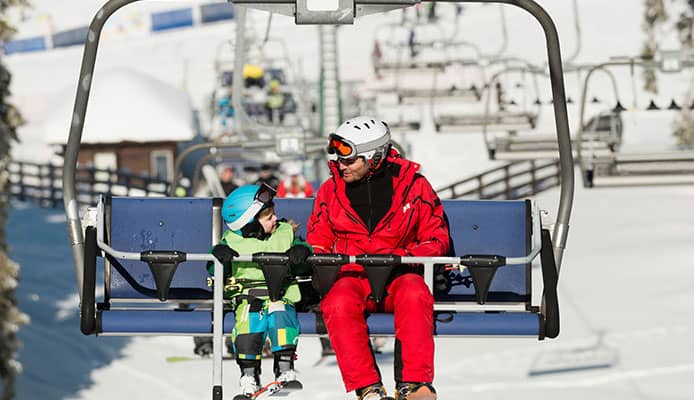
Q: What Is Flat Light In Skiing?
Flat light is a condition where there is almost no contrast between features in the terrain. This means that it’s a lot more difficult to see obstacles when skiing or assess properly how far something is. This happens when it’s snowing heavily during the day, when it’s very cloudy, or when you are skiing through clouds.
Q: What Is VLT?
VLT stands for visible light transmission and is the amount of light that passes through the lens. VLT goggles that have a lower percentage are tinted darker. Darker tints are better for sunny days and bright light conditions. Low light snow goggles should have a higher VLT percentage, which allows more light to pass through and increase your visibility on cloudy or snowy days.
However, it is important to remember that not all ski goggles for low light conditions are suitable for flat-light conditions. Brands should indicate whether their VLT goggles are better for low or flat lighting conditions. A general guide to VLT percentage is:
- 0 - 20% for clear and sunny days
- 20 - 43% for partially cloudy days
- 43 - 80% for overcast or cloudy days
- 80 - 100% for night skiing conditions
Q: What Is The Difference Between Regular Ski Goggles And Flat Light Ski Goggles?
The biggest difference is the percentage of VLT transmission. Flat light ski goggles will have a higher VLT percentage to allow more light through. On the other hand, regular VLT goggles will have a lower percentage and allow less light to go through.
Q: Why Do Goggles Help You See Better?
Lenses on ski goggles are tinted and have additional features to enhance your vision while skiing. Based on the light skiing conditions and the lens you’re using, goggles can let more or less light through, eliminate UV rays, reduce glare, or improve the contrast.
Globo Surf Overview
Skiing in flat-light can be uncomfortable and potentially dangerous. The imbalance of light and low contrast can make it hard to see the terrain and navigate the ski slopes. Luckily, with a pair of top rated flat-light goggles, you’ll be able to neutralize these problems. We hope that our guide and reviews helped you find low light goggles that will make you feel safe and comfortable in flat-light conditions.
More Snow Ski Gear Reviews:
- Ski Locks
- Ski Goggles For Flat Light
- Kids Ski Goggles
- Ski Walkie Talkies
- Ski Helmet Headphones
- Ski Carry Straps
- Ski Helmets With Visors
- Ski Boots For Wide Feet
- OTG Ski Goggles
- Sunglasses For Skiing
- Kids Ski Pants
- Night Skiing Goggles
- Ski Mid-layers
- Base Layers For Skiing
- Ski Racks
- Skis For Beginners
- Ski Bags
- Gifts For Skiers And Snowboarders
- Avalanche Shovels
- Cameras For Skiing
More Goggles Reviews:
Do you own a pair of the goggles for flat-light that made it onto our list? Have they improved your safety in low light conditions? Let us know how your flat-light goggles have improved your vision in the comments section below.


